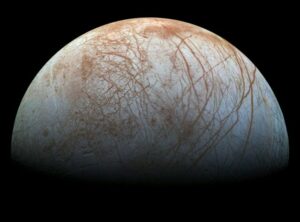The Europa Clipper mission launched Monday for a six-year journey that will take it to Jupiter and its icy satellite Europa.
The spacecraft launched from the Kennedy Space Center in Florida at 12:06 p.m. (local time, 7:06 p.m. in Greece) Monday. The original plan was to launch on Thursday but the mission was postponed due to Hurricane Milton.
Its course will bring it close to Mars and then close to Earth to be hurled towards Jupiter. It will reach its destination in 2030 after a 3.6 billion-kilometer journey.
The six-ton craft is one of the largest NASA has ever built, the Guardian writes. It will be up to 30 meters long when the huge solar panels are opened up to take power that far from the Sun.
Its mission is to study Europa, Jupiter’s icy moon, one of the four largest along with Ganymede, Callisto and Io.

For two decades we have known that beneath the frozen surface there is a vast ocean. Conditions inside the ocean may be conducive to the existence of life.
The Europa Clipper will photograph the entire surface of Europa and use its instruments to search the surface for “fingerprints” of organic compounds and detect gases that are released.
Previous observations of Europa had revealed giant jets of water spewing from its icy surface. It is estimated that the ocean, which is beneath a 15- to 20-kilometer layer of ice, is more than 100 kilometers deep, with twice as much salt water by volume as the entire Earth has.
Near Jupiter, the spacecraft will also face very high levels of radiation that threaten to destroy its delicate electronics. For protection reasons the Clipper will not fly around Europa but in an orbit that takes it out of the danger zone. However, each time it approaches it will receive radiation equivalent to a million chest X-rays.
Ask me anything
Explore related questions

